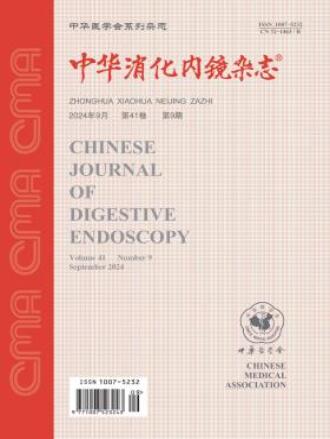基于超声内镜的食管静脉曲张发生风险评估模型
引用次数: 0
摘要
目的通过超声内镜(EUS)识别肝硬化食管静脉曲张(EV)发生的独立危险因素,建立预测EV发生的风险评估模型,并评价该模型的临床预测价值。方法采用回顾性队列研究。收集2014年9月至2017年3月天津市第二人民医院住院的肝硬化无静脉曲张患者资料。EUS测量食管侧支循环的位置、直径和数量。记录非选择性受体阻滞剂(NSBB)用药史及抗病毒治疗情况。以首次EUS检查时间为起点,随访期为18个月。终点为发生EV或随访结束。通过单因素和多因素logistic回归分析确定EV发生的独立危险因素,构建EV发生的风险评估模型。采用ROC分析研究评价模型对疾病的预测价值。采用Hosmer-Lemeshow拟合优度检验评价模型的拟合效率。结果最初共招募638名受试者,其中13名在研究过程中丢失。最终,625例病例被纳入研究。其中未发生EV 369例(非进展组),发生EV 256例(进展组)。(1)多因素logistic回归分析显示,将7个独立危险因素纳入EV发生的风险评估模型,并给予相应的评分:无NSBB(3分)、未抗病毒治疗(2分)、Child-Pugh B期(1分)、周围ecv直径> 2mm(1分)、周围ecv个数≥5(3分)、旁ecv直径≥5 mm(4分)、旁ecv个数≥5(4分)。(2)风险评估模型中风险因素得分范围为1 ~ 4分,总分为0 ~ 18分。随着评分的增加,EV的预测发病率从0.003增加到1.000。(3)在风险评估模型中,总风险评分≤2分为低危组,3-5分为中危组,≥6分为高危组。低危组、中危组和高危组的EV实际发生率分别为2.78%、36.36%和93.91%。(4) ROC分析显示,曲线下面积(AUC)为0.947 (P<0.05),提示风险评估模型对疾病进展有较好的预测效果。Hosmer-Lemeshow检验显示P为0.450,表明模型拟合良好。结论基于EUS的风险评估模型能准确预测EV的发生,且简单易用。该模型可为肝硬化EV的预防和合理治疗提供科学依据。关键词:肝硬化;静脉曲张;Endosonography;物流模型本文章由计算机程序翻译,如有差异,请以英文原文为准。
A risk assessment model for esophageal varices occurrence based on endoscopic ultrasonography
Objective
To identify the independent risk factors of esophageal varices (EV) in cirrhosis by endoscopic ultrasonography (EUS), and further to establish a risk assessment model for predicting EV occurrence and evaluate the clinical predictive value of the model.
Methods
A retrospective cohort study was used in this study. Data of patients with cirrhosis without varicosity, who were hospitalized in Tianjin Second People's Hospital from September 2014 to March 2017 were collected. The location, diameter, and number of esophageal collateral circulation were measured by EUS. The non-selective beta blocker (NSBB) medication history and antiviral therapy were recorded. The time of the first EUS examination was taken as the starting point and the follow-up period was set up as 18 months. The end point was the occurrence of EV or the end of follow-up. The independent risk factors of EV occurrence were determined by univariate and multivariate logistic regression analysis, and the risk assessment model of EV occurrence was constructed. The predictive value of evaluation model for disease was studied by ROC analysis. Hosmer-Lemeshow goodness of fit was used to test the fitting efficiency of the evaluation model.
Results
A total of 638 subjects were recruited initially, 13 of them were lost in the course of the study. Finally, 625 cases were included in the study. Among them, 369 cases did not develop EV (the non-progress group) and 256 cases developed EV (the progress group). (1) Multivariate logistic regression analysis showed that 7 independent risk factors were selected into the risk assessment model of EV occurrence, and were assigned corresponding scores: no NSBB (3 points), no antiviral treatment (2 points), Child-Pugh stage B (1 point), the diameter of peri-ECV>2 mm (1 point), the number of peri-ECV≥5 (3 points), the diameter of para-ECV≥5 mm (4 points), and the number of para-ECV≥5 (4 points). (2) In the risk assessment model, the risk factor scores ranged from 1 to 4 with a total score of 0-18. The predicted incidence of EV increased from 0.003 to 1.000 with the increase of the score. (3) In the risk assessment model, the total risk score ≤2 was assigned into low-risk group, 3-5 into medium-risk group, and ≥6 into high-risk group. The actual EV incidence of each risk stratification was 2.78% in the low-risk group, 36.36% in the medium-risk group and 93.91% in the high-risk group, respectively. (4) The ROC analysis showed that area under curve (AUC) was 0.947 (P<0.05), suggesting that the risk assessment model had a good effect on predicting disease progression. Hosmer-Lemeshow test showed that P was 0.450, suggesting that the model fitted well.
Conclusion
The risk assessment model based on EUS can accurately predict the occurrence of EV, and is simple and easy to use. The model can provide scientific basis for the prevention and rational treatment of EV in liver cirrhosis.
Key words:
Liver cirrhosis; Varicose veins; Endosonography; Logistic models
求助全文
通过发布文献求助,成功后即可免费获取论文全文。
去求助
来源期刊
CiteScore
0.10
自引率
0.00%
发文量
7555
期刊介绍:
Chinese Journal of Digestive Endoscopy is a high-level medical academic journal specializing in digestive endoscopy, which was renamed Chinese Journal of Digestive Endoscopy in August 1996 from Endoscopy.
Chinese Journal of Digestive Endoscopy mainly reports the leading scientific research results of esophagoscopy, gastroscopy, duodenoscopy, choledochoscopy, laparoscopy, colorectoscopy, small enteroscopy, sigmoidoscopy, etc. and the progress of their equipments and technologies at home and abroad, as well as the clinical diagnosis and treatment experience.
The main columns are: treatises, abstracts of treatises, clinical reports, technical exchanges, special case reports and endoscopic complications.
The target readers are digestive system diseases and digestive endoscopy workers who are engaged in medical treatment, teaching and scientific research.
Chinese Journal of Digestive Endoscopy has been indexed by ISTIC, PKU, CSAD, WPRIM.

 求助内容:
求助内容: 应助结果提醒方式:
应助结果提醒方式:


